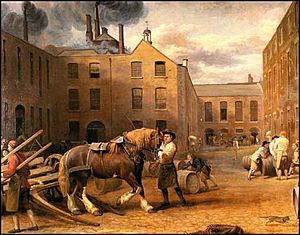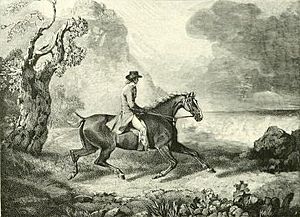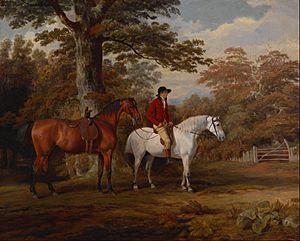George Garrard facts for kids
George Garrard (born May 31, 1760 – died October 8, 1826) was a talented English artist. He was known for painting animals, landscapes, and portraits. He also created sculptures, models, and prints. George Garrard was very important in helping to create a law that protected artists' copyright. This meant that artists could own their original ideas and creations, especially for models of people and animals.
Life as an Artist


George Garrard came from a family of artists. One of his ancestors was a painter for Queen Elizabeth I! George first learned art from a teacher named Joseph Simpson. Later, he studied with Sawrey Gilpin. In 1778, he joined the Royal Academy, a famous art school in London.
In 1781, George Garrard showed his paintings of horses and dogs at the Royal Academy for the first time. A few years later, he painted a "View of a Brewhouse Yard." This painting caught the eye of a very famous artist, Sir Joshua Reynolds, who asked George to paint a similar picture for him.
In 1795, George had a new idea. He thought that plaster models of farm animals could be really helpful for landscape painters. From then on, he started both painting and making models.
Protecting Artists' Work
Because he was making models, George Garrard realized that artists needed a law to protect their creations. In 1797, with help from the Royal Academy and other sculptors, he asked the British Parliament to create a new law. This led to "The Models and Busts Act" in 1798. This law was a big deal! For the first time, British law protected the copyright of models and sculptures, not just printed books or pictures.
In 1800, George Garrard became an Associate of the Royal Academy. This was a special honor for artists. That same year, he published a large book with colorful pictures called "A Description of the different varieties of Oxen common in the British Isles."
After 1804, George Garrard mostly focused on making sculptures and models. He used both oil paints and watercolors for his paintings. He also showed many sculptures at the Royal Academy. These included busts (sculptures of a person's head and shoulders), medallions, and groups of animals. He made these from marble, bronze, or plaster.
George Garrard showed a total of 215 artworks at the Royal Academy! He also painted a very large picture called "Woburn Sheep-shearing in 1804." This painting included 88 portraits of important people from that time. It was so big it hung in Woburn Abbey, a grand house.
George Garrard passed away on October 8, 1826, in London. He was with his family at church.
Family Life
George Garrard married Matilda Gilpin. She was the oldest daughter of his art teacher, Sawrey Gilpin.
Sculptures by George Garrard
Here are some of the sculptures George Garrard created:
- Bust of Benjamin West (1803)
- Bust of Henry Holland (1803 and 1806)
- Bust of Thomas Adkin (1803)
- Bust of Sir Joseph Banks (1804)
- Bust of Sawrey Gilpin (1806)
- Bust of the Earl of Egremont (1807)
- Bust of Charles James Fox (1807)
- Terracotta bust of Pitt (1808)
- Bust of Humphrey Repton (1810)
- Bust of William Wilberforce (1810)
- Bust of Richard Brinsley Sheridan (1813)


